Spring JDBC
概念
Spring的JDBC模块负责数据库资源管理和错误处理,简化了开发人员对数据库的操作。
Spring JDBC通过配置数据源和JDBC模板来配置。
针对数据库操作,Spring框架提供了JdbcTemplate类,它是Spring框架数据抽象层的基础,是Spring JDBC的核心类。
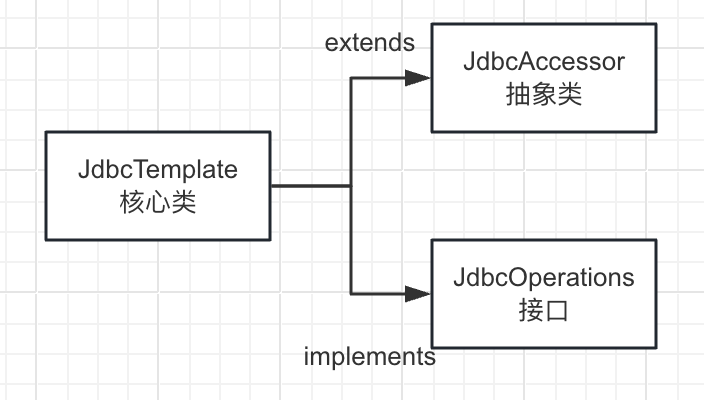
JdbcAccessor提供了访问数据库使用的公共属性,例如Data Source,DataSource主要功能是获取数据库连接,还可以引入对数据库连接的缓冲池和分布式事务的支持;JdbcOperations定义了可以使用的操作集合,例如增删改查(CURD)。
Spring JDBC模块由4个包组成:
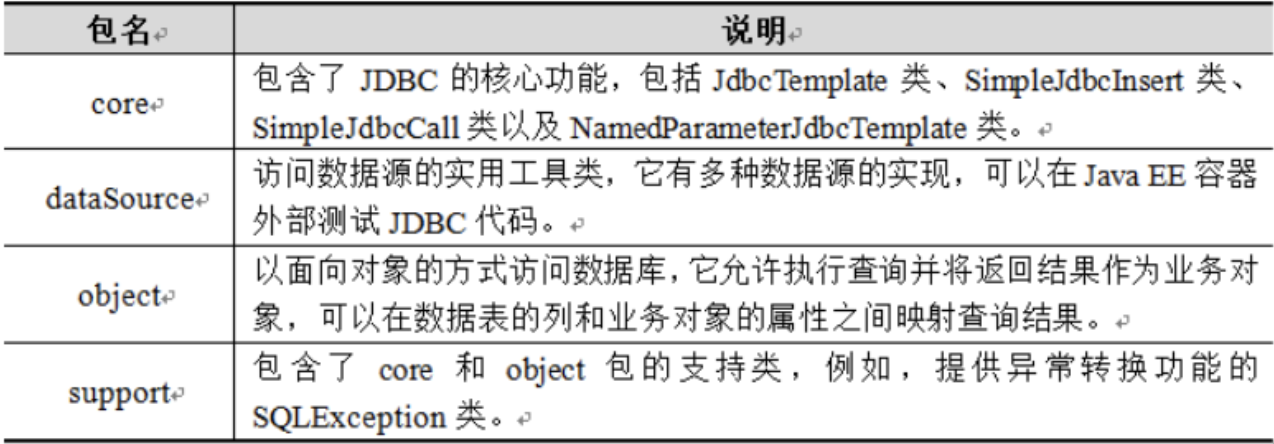
下面我们真正来用一下。
Spring JDBC实践
数据库创建
首先我们在MySQL中创建一个数据库,由于我是Mac环境,所以我直接在终端中执行SQL语句来完成。
如果你没有修改过密码,执行以下命令
mysql -uroot
如果修改过密码请执行以下命令,根据提示输入密码,输入的时候看不见
mysql -u root -p
如果你是Windows可以通过sqlyog连接。
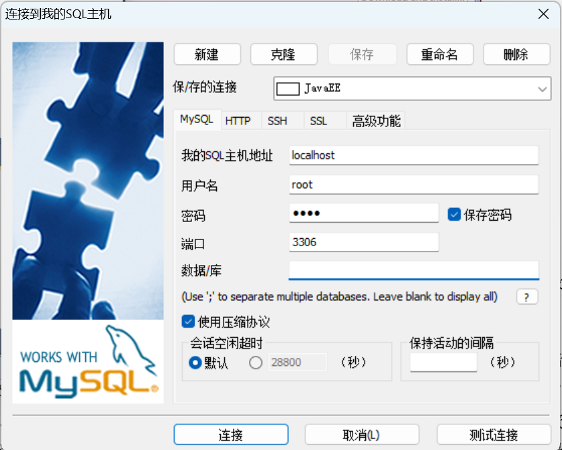
以下部分通用:
执行SQL语句创建数据库
CREATE DATABASE db_javaee;
我们接下来为这个数据库创建一个单独的用户来管理它,用户名为db_javaee,密码是dbjavaeepassword。
CREATE USER 'db_javaee'@'localhost' IDENTIFIED BY 'dbjavaeepassword';
这里有必要说明下,如果数据库与你开发环境在同一台机器上,这里可写'localhost',如果是远程的数据库要改为'%',即(以下同理)
CREATE USER 'db_javaee'@'%' IDENTIFIED BY 'dbjavaeepassword';
给这个用户授予权限,如果是远程别忘了改成'%'
GRANT ALL ON db_javaee.* TO 'db_javaee'@'localhost';
刷新权限
flush privileges;
这里有个问题得注意下,如果你的MySQL版本是5.7到这里就没啥问题了。如果是MySQL8.0以及更高,则加密算法由原来的sha256_password改成了caching_sha2_password,导致连接新版本数据库报错。
新版本用户需要追加
ALERT USER 'db_javaee'@'localhost' IDENTIFIED WITH mysql_native_password by 'dbjavaeepassword';
如果你root用户登陆不上也有可能是因为这个原因,这时候你就要像Mac用户一样到终端里连接,并将此处的db_javaee改为root才能在旧版sqlyog里或者navcat里连接。
项目创建
我们还是创建一个Maven项目,名称为top.cairbin.test3,然后在pom.xml里添加依赖包
<dependency><groupId>org.springframework</groupId><artifactId>spring-context</artifactId><version>5.1.5.RELEASE</version>
</dependency>
<dependency><groupId>org.springframework</groupId><artifactId>spring-jdbc</artifactId><version>5.1.5.RELEASE</version>
</dependency>
<dependency><groupId>mysql</groupId><artifactId>mysql-connector-java</artifactId><version>8.0.33</version>
</dependency>
<dependency><groupId>org.springframework</groupId><artifactId>spring-test</artifactId><version>5.1.5.RELEASE</version><scope>test</scope>
</dependency>
注意这里的mysql-connector-java请用较新的,我之前用5.1.47会报错。
同样创建与src平级的resources目录并use as source folder,在里面创建app.xml(跟我们之前的AppCtx.xml一样,名称不固定随你便,不过在main中的必须与这里的文件名一致),并写入如下内容
<?xml version="1.0" encoding="UTF-8"?>
<beans xmlns="http://www.springframework.org/schema/beans"xmlns:xsi="http://www.w3.org/2001/XMLSchema-instance"xmlns:context="http://www.springframework.org/schema/context"xsi:schemaLocation="http://www.springframework.org/schema/beans http://www.springframework.org/schema/beans/spring-beans.xsdhttp://www.springframework.org/schema/context http://www.springframework.org/schema/context/spring-context.xsd"><!-- 指定需要扫描的包,使注解生效 --><context:component-scanbase-package="top.cairbin.test3" /><!-- 配置dataSource --><bean id="dataSource"class="org.springframework.jdbc.datasource.DriverManagerDataSource"><!--数据库驱动 --><property name="driverClassName"value="com.mysql.jdbc.Driver" /><!--连接数据库的url --><property name="url"value="jdbc:mysql://localhost:3306/db_javaee" /><!--连接数据库的用户名 --><property name="username" value="db_javaee" /><!--连接数据库的密码 --><property name="password" value="dbjavaeepassword" /></bean><!-- 配置JDBC模板 --><bean id="jdbcTemplate"class="org.springframework.jdbc.core.JdbcTemplate"><!-- 默认必须使用数据源 --><property name="dataSource" ref="dataSource" /></bean>
</beans>
如果你数据库用户名和密码设置与我不一样,记得修改这里的value属性。
在App.java中测试
package top.cairbin.test3;import org.springframework.context.ApplicationContext;
import org.springframework.context.support.ClassPathXmlApplicationContext;
import org.springframework.jdbc.core.JdbcTemplate;public class App
{public static void main( String[] args ){ApplicationContext applicationContext = new ClassPathXmlApplicationContext("app.xml");// 获取JdbcTemplate实例JdbcTemplate jdTemplate = (JdbcTemplate) applicationContext.getBean("jdbcTemplate");// 使用execute()方法执行SQL语句,创建用户账户管理表accountjdTemplate.execute("create table account(" + "id int primary key auto_increment," +"username varchar(50)," + "balance double)");System.out.println("账户表account创建成功!");}
}
点击运行按钮后就可以看到表创建成功了

编写测试
我们创建一个Account测试类
package top.cairbin.test3;public class Account {private int id; // 账户idprivate String username; // 用户名private double balance; // 账户余额public Integer getId() {return id;}public void setId(Integer id) {this.id = id;}public String getUsername() {return username;}public void setUsername(String username) {this.username = username;}public Double getBalance() {return balance;}public void setBalance(Double balance) {this.balance = balance;}public String toString() {return "Account [id=" + id + ", "+ "username=" + username + ", balance=" + balance + "]";}
}
再建立一个IAccountDao接口
package top.cairbin.test3;import java.util.List;public interface IAccountDao {// 添加public int addAccount(Account account);// 更新public int updateAccount(Account account);// 删除public int deleteAccount(int id); // 通过id查询public Account findAccountById(int id);// 查询所有账户public List<Account> findAllAccount();
}
然后定义AccountDao类实现这个接口
package top.cairbin.test3;
import java.util.List;import org.springframework.beans.factory.annotation.Autowired;
import org.springframework.jdbc.core.BeanPropertyRowMapper;
import org.springframework.jdbc.core.JdbcTemplate;
import org.springframework.jdbc.core.RowMapper;
import org.springframework.stereotype.Repository;@Repository("accountDao")
public class AccountDao implements IAccountDao {// 声明JdbcTemplate属性并添加注解@Autowired
private JdbcTemplate jdbcTemplate;// 添加账户public int addAccount(Account account) {// 定义SQLString sql = "insert into account(username,balance) value(?,?)";// 定义数组来存放SQL语句中的参数Object[] obj = new Object[] { account.getUsername(), account.getBalance() };// 执行添加操作,返回的是受SQL语句影响的记录条数int num = this.jdbcTemplate.update(sql, obj);return num;}// 更新账户public int updateAccount(Account account) {// 定义SQLString sql = "update account set username=?,balance=? where id = ?";// 定义数组来存放SQL语句中的参数Object[] params = new Object[] { account.getUsername(), account.getBalance(), account.getId() };// 执行添加操作,返回的是受SQL语句影响的记录条数int num = this.jdbcTemplate.update(sql, params);return num;}// 删除账户public int deleteAccount(int id) {// 定义SQLString sql = "delete from account where id = ? ";// 执行添加操作,返回的是受SQL语句影响的记录条数int num = this.jdbcTemplate.update(sql, id);return num;}// 通过id查询账户数据信息public Account findAccountById(int id) {//定义SQL语句String sql = "select * from account where id = ?";// 创建一个新的BeanPropertyRowMapper对象RowMapper<Account> rowMapper = new BeanPropertyRowMapper<Account>(Account.class);// 将id绑定到SQL语句中,并通过RowMapper返回一个Object类型的单行记录return this.jdbcTemplate.queryForObject(sql, rowMapper, id);}// 查询所有账户信息public List<Account> findAllAccount() {// 定义SQL语句String sql = "select * from account";// 创建一个新的BeanPropertyRowMapper对象RowMapper<Account> rowMapper = new BeanPropertyRowMapper<Account>(Account.class);// 执行静态的SQL查询,并通过RowMapper返回结果return this.jdbcTemplate.query(sql, rowMapper);}}
创建测试类SpringJdbcTest,编写测试单元
package top.cairbin.test3;import org.junit.jupiter.api.Test;
import org.springframework.context.ApplicationContext;
import org.springframework.context.support.ClassPathXmlApplicationContext;
import org.springframework.jdbc.core.JdbcTemplate;public class SpringJdbcTest {@Testpublic void mainTest() {// 加载配置文件ApplicationContext applicationContext = new ClassPathXmlApplicationContext("app.xml");// 获取JdbcTemplate实例JdbcTemplate jdTemplate = (JdbcTemplate) applicationContext.getBean("jdbcTemplate");// 使用execute()方法执行SQL语句,创建用户账户管理表accountjdTemplate.execute("create table account(" + "id int primary key auto_increment," +"username varchar(50)," + "balance double)");System.out.println("账户表account创建成功!");}@Testpublic void addAccountTest() {// 加载配置文件ApplicationContext applicationContext = new ClassPathXmlApplicationContext("app.xml");// 获取AccountDao实例IAccountDao accountDao = (IAccountDao) applicationContext.getBean("accountDao");// 创建Account对象,并向Account对象中添加数据Account account = new Account();account.setUsername("tom");account.setBalance(1000.00);// 执行addAccount()方法,并获取返回结果int num = accountDao.addAccount(account);if (num > 0) {System.out.println("成功插入了" + num + "条数据!");} else {System.out.println("插入操作执行失败!");}}@Testpublic void updateAccountTest() {// 加载配置文件ApplicationContext applicationContext = new ClassPathXmlApplicationContext("applicationContext.xml");// 获取AccountDao实例IAccountDao accountDao = (IAccountDao) applicationContext.getBean("accountDao");// 创建Account对象,并向Account对象中添加数据Account account = new Account();account.setId(1);account.setUsername("tom");account.setBalance(2000.00);// 执行updateAccount()方法,并获取返回结果int num = accountDao.updateAccount(account);if (num > 0) {System.out.println("成功修改了" + num + "条数据!");} else {System.out.println("修改操作执行失败!");}}@Testpublic void deleteAccountTest() {// 加载配置文件ApplicationContext applicationContext = new ClassPathXmlApplicationContext("app.xml");// 获取AccountDao实例IAccountDao accountDao = (IAccountDao) applicationContext.getBean("accountDao");// 执行deleteAccount()方法,并获取返回结果int num = accountDao.deleteAccount(1);if (num > 0) {System.out.println("成功删除了" + num + "条数据!");} else {System.out.println("删除操作执行失败!");}}
}
在Eclipse中src/main/java使用@Test注解需要进行配置:右键项目-> properties -> Java Build Path -> Libraries -> Add Library -> JUint
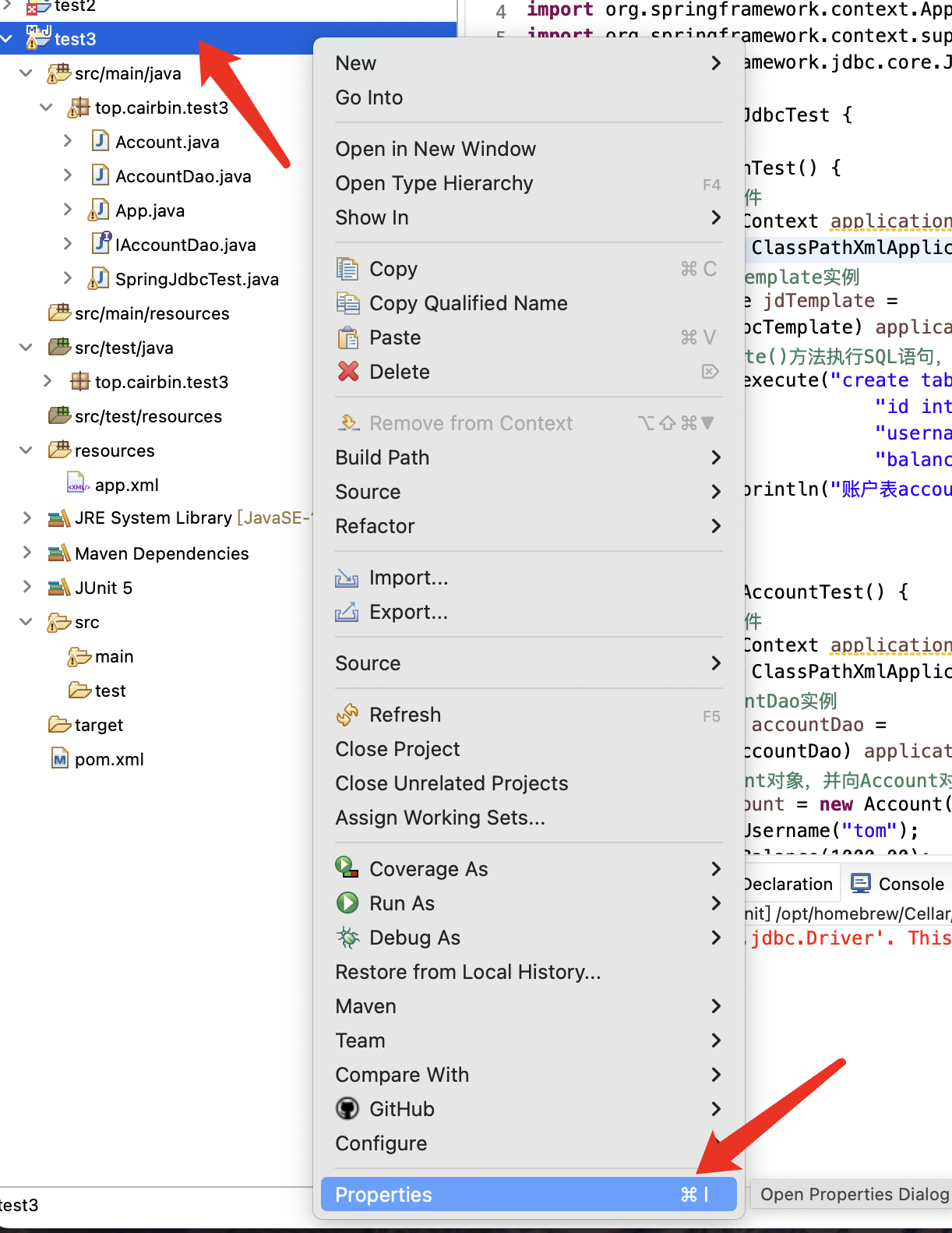
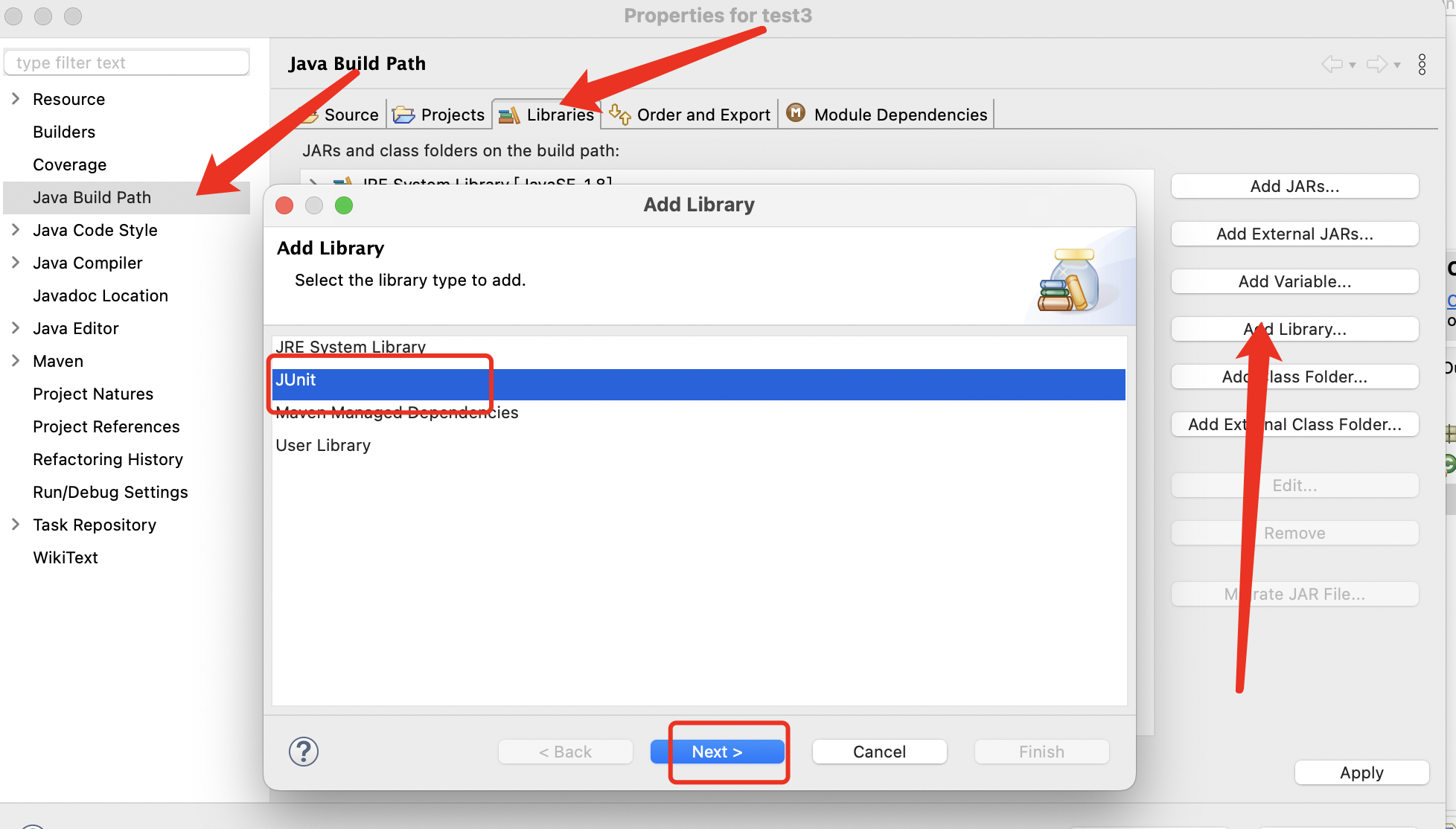
添加完成后导入包import java.util.List;就能用了。

点击运行,我这里已经测试了多次了,结果可能跟你的不一样
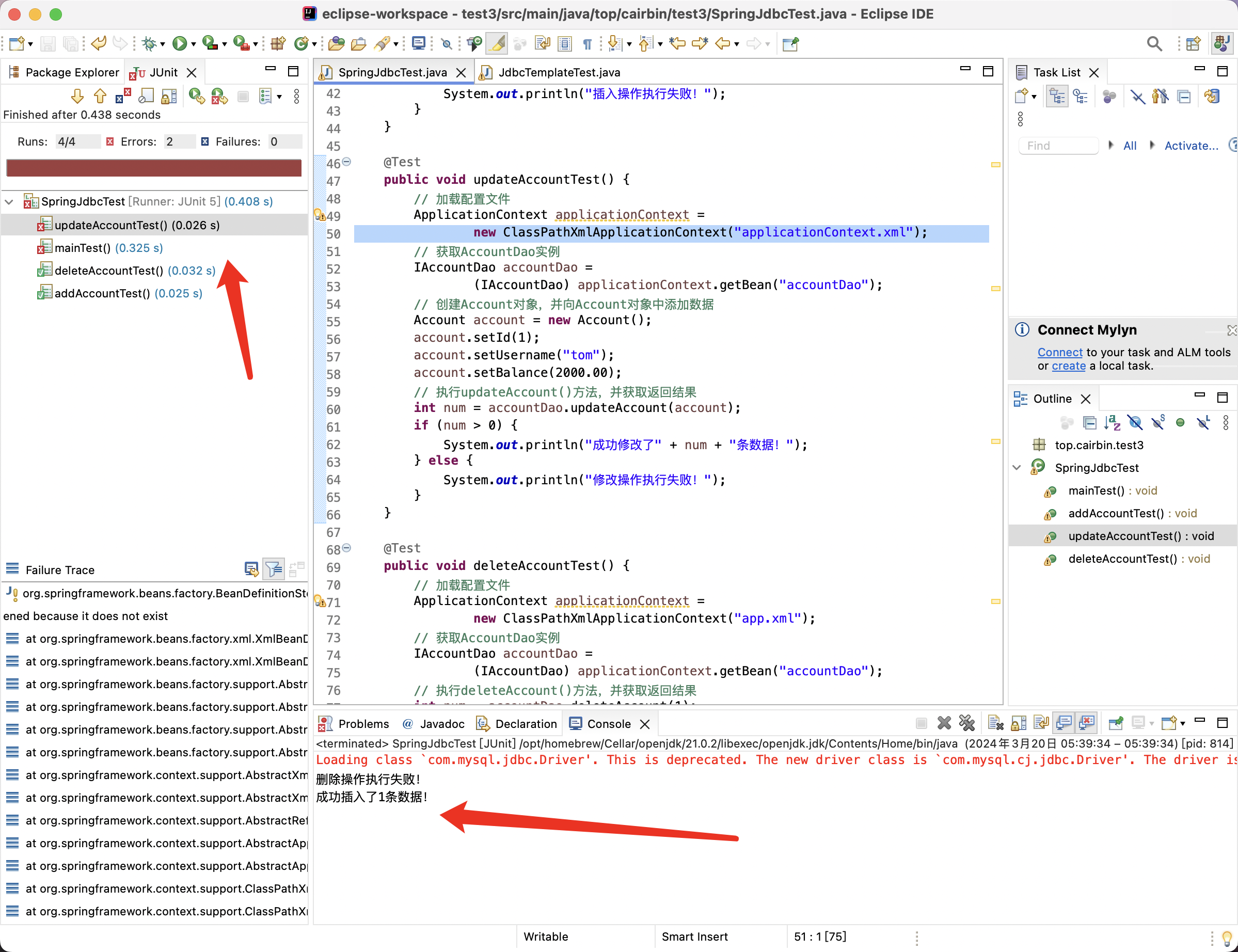
从图中左侧可以看到两个方法成功了,两个方法失败了。失败的方法图标又个红色的叉号。
我们再创建一个JdbcTemplateTest类,测试下查询方法
package top.cairbin.test3;import java.util.List;import org.junit.jupiter.api.Test;
import org.springframework.context.ApplicationContext;
import org.springframework.context.support.ClassPathXmlApplicationContext;
import org.springframework.jdbc.core.JdbcTemplate;public class JdbcTemplateTest {@Testpublic void findAccountByIdTest() {// 加载配置文件ApplicationContext applicationContext = new ClassPathXmlApplicationContext("app.xml");// 获取AccountDao实例IAccountDao accountDao = (IAccountDao) applicationContext.getBean("accountDao");// 执行findAccountById()方法Account account = accountDao.findAccountById(1);System.out.println(account);}@Testpublic void findAllAccountTest() {// 加载配置文件ApplicationContext applicationContext = new ClassPathXmlApplicationContext("app.xml");// 获取AccountDao实例IAccountDao accountDao = (IAccountDao) applicationContext.getBean("accountDao");// 执行findAllAccount()方法,获取Account对象的集合List<Account> account = accountDao.findAllAccount();// 循环输出集合中的对象for (Account act : account) {System.out.println(act);}}
}
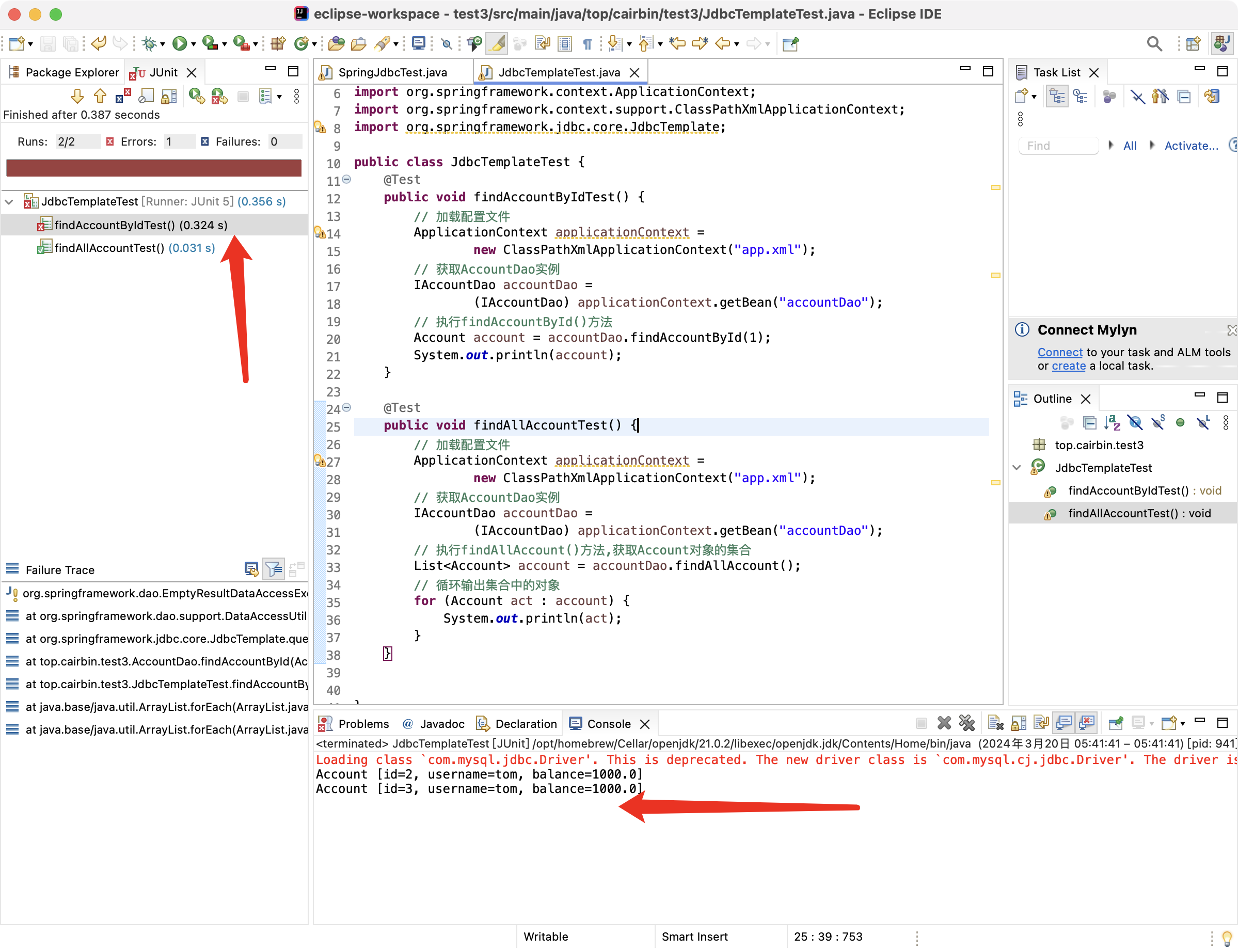
关于SpringTest
在Spring中使用Junit测试,每一个测试方法都会初始化Spring容器,导致容器被初始化多次,需要通过ctx.getBean()获取测试Bean。
SpringTest可以解决上面的问题,通过在类之上添加注解即可
@RunWith(SpringJUnit4ClassRunner.class)
@ContextConfiguration(locations="classpath:applicationContext.xml")
这里的Junit版本为4.12,需要修改pom.xml。
此处不对该功能过多解释。


)













)
)

